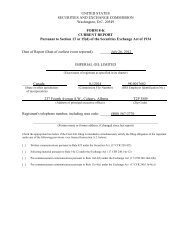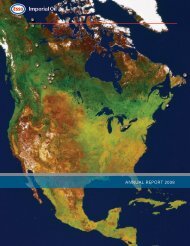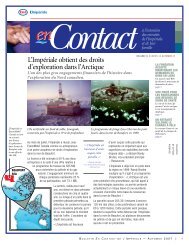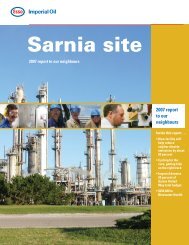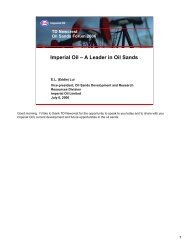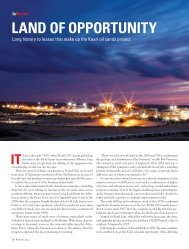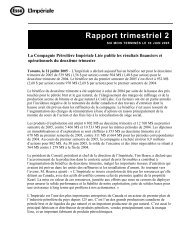FORM 10-K IMPERIAL OIL LIMITED
FORM 10-K IMPERIAL OIL LIMITED
FORM 10-K IMPERIAL OIL LIMITED
You also want an ePaper? Increase the reach of your titles
YUMPU automatically turns print PDFs into web optimized ePapers that Google loves.
Notes to consolidated financial statements (continued)<br />
The company does not use financing structures for the purpose of altering accounting outcomes or removing debt from the balance sheet. The company<br />
does not use derivative instruments to speculate on the future direction of currency or commodity prices and does not sell forward any part of production<br />
from any business segment.<br />
Revenues<br />
Revenues associated with sales of crude oil, natural gas, petroleum and chemical products and other items are recorded when the products are delivered.<br />
Delivery occurs when the customer has taken title and has assumed the risks and rewards of ownership, prices are fixed or determinable and<br />
collectibility is reasonably assured. The company does not enter into ongoing arrangements whereby it is required to repurchase its products, nor does<br />
the company provide the customer with a right of return.<br />
Revenues include amounts billed to customers for shipping and handling. Shipping and handling costs incurred up to the point of final storage prior to<br />
delivery to a customer are included in ”purchases of crude oil and products” in the consolidated statement of income. Delivery costs from final storage to<br />
customer are recorded as a marketing expense in selling and general expenses.<br />
Revenues include the sales portion of certain transactions where the Company contemporaneously negotiates purchases with the same counterparty under<br />
contractual arrangements that establish the agreement terms either jointly, in a single contract, or separately in individual contracts. The purchases are<br />
re c o rded in “purchases of crude oil and products”. These transactions are commonly called purchase/sale transactions. Together with non-monetary<br />
exchanges as well as independently transacted purchases and sales, purchase/sale transactions are used to ensure that the right crude oil is at the<br />
a p p ropriate refineries at the right time and the appropriate products are available to meet consumer demands.<br />
Each purchase/sale transaction is composed of a separate purchase and a separate sale transaction and therefore is accounted for as any other<br />
independently transacted monetary purchase or sale, measured at fair value as agreed upon by a willing buyer and a willing seller. They are entered into<br />
with our normal suppliers and customers for substantive business purposes and physical delivery is required.<br />
This accounting practice has recently been addressed in EITF Issue 03-11, “Reporting Realized Gains and Losses on Derivative Instruments That Are<br />
Subject to FASB Statement No. 133 and Not Held for Trading Purposes as Defined in Issue No. 02-03”. While Issue 03-11 addresses the issue of gross<br />
versus net classification for derivative instruments, it also provides guidance for purchase/sale transaction that are not accounted for as derivative<br />
instruments. In Issue 03-11, the EITF concluded that the determination of whether contracts not held for trading purposes should be reported in the<br />
income statement on a gross or net basis is a matter of judgment that depends on the relevant facts and circumstances. In the judgment of management,<br />
the relevant facts and circumstances support accounting for these transactions in revenues, measured at fair value.<br />
Stock-based compensation<br />
The company accounts for its stock-based compensation programs, except for the incentive stock options granted in April 2002, by using the fair-valuebased<br />
method. Under this method, compensation expense related to the units of these programs is measured by the fair value of the liabilities incurred<br />
and is recorded in the consolidated statement of income over the vesting period. The fair value of liabilities is remeasured at the end of each reporting<br />
period through settlement.<br />
As permitted by the Statement of Financial Accounting Standards No.123 (SFAS 123), the company continues to apply the intrinsic-value-based method of<br />
accounting for the incentive stock options granted in April 2002. Under this method, compensation expense is not recognized on the issuance of stock<br />
options as long as the exercise price is equal to the market value at the date of grant.<br />
If the provisions of SFAS 123 had been adopted for all prior years, net income and net income per share would have been as follows:<br />
millions of dollars 2004 2003 2002<br />
Net income as shown in financial statements 2 052 1 705 1 214<br />
Add: stock-based compensation expense as reported, net of tax 84 76 24<br />
Deduct: stock-based compensation expense, net of tax, determined under fair-value-based method (86) (81) (41)<br />
Pro forma net income 2 050 1 700 1 197<br />
Net income per share ( d o l l a r s)<br />
As reported – basic 5.75 4.58 3.20<br />
– diluted 5.74 4.58 3.20<br />
Pro forma – basic 5.74 4.57 3.16<br />
– diluted 5.73 4.57 3.16<br />
Consumer taxes<br />
Taxes levied on the consumer and collected by the company are excluded from the consolidated statement of income. These are primarily<br />
provincial taxes on motor fuels and the federal goods and services tax.<br />
F-9



